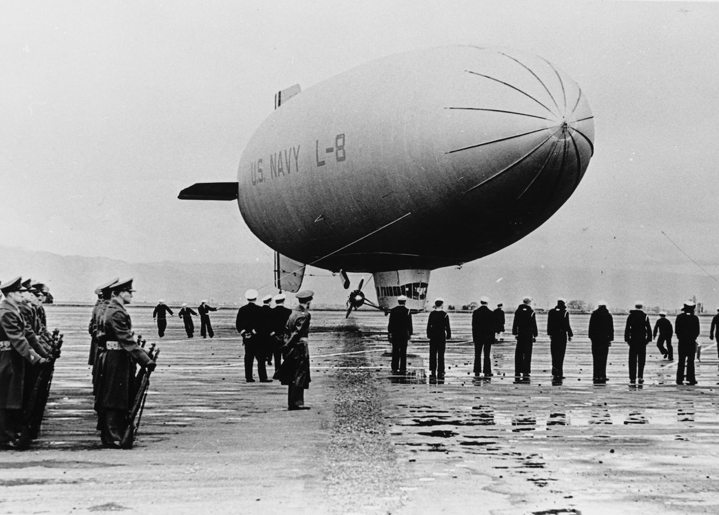L-8 Ghost Blimp: The WWII Blimp Whose Crew Disappeared
The L-8 blimp before its crew disappeared at the beginning of World War II. Photo: The Smithsonian
In August 1942, the L-8 came back from its patrol of the California coast to search for Japanese submarines, but its two-person crew was no where to be seen.
What was the L-8 Ghost Blimp?
The L-8 ghost blimp was an airship used by the U.S Navy during WWII for guarding against incoming Japanese attacks.
The U.S. had been engaged in war for slightly more than eight months at the time, and Americans were anxious about potential Japanese attacks on the West Coast. To keep a lookout for Japanese submarines, the Navy gathered a group of airships there, similar to the way it did on the East Coast to patrol for German U-boats.
The majority of the airships that the Navy relied upon for this task were blimps. Blimps differed from rigid airships with an internal metal structure, such as Germany's zeppelins, because they were constructed primarily of a gas-filled envelope, or balloon, and a control car or gondola that was attached underneath.
Because of their straightforward design, blimps were able to be operated by small teams and could even float unoccupied unless their envelope was punctured and the gas leaked out.
Who were the crew of the L-8 Ghost Blimp?
Lieutenant Ernest DeWitt Cody in 1938. Photo: USNA Virtual Memorial Hall
The L-8 blimp was manned by two experienced airship pilots, Lieutenant Ernest DeWitt Cody and Ensign Charles Ellis Adams.
Cody was 27 and a graduate of the Naval Academy in 1938, while Adams, aged 34, had served in the Navy for more than ten years. He was onboard and survived the U.S.S. Macon airship disaster off the California coast in 1935.
A machinist's mate named James Riley Hill was also on board initially, but Cody instructed him to disembark just before the L-8 departed, allegedly due to concerns about the additional weight.
What Happened to the L-8 Ghost Blimp and her Crew?
The wreckage of the L-8 ghost blimp after it crashed on a suburban street.
On August 16, 1942, at approximately 6 a.m., the L-8 blimp of the United States Navy departed from a small airfield located on Treasure Island, an island built in San Francisco Bay for a recent world’s fair.
During the initial hour and a half of the flight, nothing noteworthy occurred. However, at 7:50 a.m., the crew radioed that they had discovered an oil slick in the water, which could have been a sign of a submarine.
They reported that they were going in to examine it. This was the final communication the crew had with the outside world.
The Navy dispatched search planes to locate the L-8 when it failed to report back. Concerns were briefly alleviated when a military base nearby reported that the blimp had landed there and its pilots had disembarked.
It was later discovered that this information was inaccurate, and the blimp had actually landed on a beach a mile away. Witnesses claimed that no one was on board, and despite their efforts to restrain it, the blimp ascended again and drifted towards Daly City.
Upon arrival in Daly City, authorities discovered that the door to the blimp's control car was open, but there was no indication of damage or fire. The radio was functional, and the pilots' parachutes were still untouched.
The blimp was missing one of its anti-submarine depth charges, which was later found on a nearby golf course. The only other items missing were the pilots' lifejackets, commonly referred to as "Mae Wests," after the actress and comedian with an hourglass figure. This was not unexpected as wearing lifejackets during flight was standard protocol.
As investigators delved deeper into the incident, the enigma only intensified. On the day in question, the waters off San Francisco were bustling with fishing boats, Navy vessels, and Coast Guard ships, resulting in several eyewitnesses observing the blimp's movements.
Based on various accounts compiled by the investigators, the blimp released two smoke flares over the oil slick to indicate its location before ascending to a higher altitude. A Pan Am Clipper seaplane passing by witnessed the blimp's flight.
Later, a search plane spotted it at an altitude of 2,000 feet, which was twice as high as its typical flying altitude, before it descended back under the clouds.
As the blimp deflated and became increasingly misshapen, hundreds of onlookers on the ground followed its progress through the skies. One observer later likened it to a "big broken wiener." Some spectators took photographs, which the police attempted to seize.
As is typical in such situations, witnesses provided conflicting reports. Some claimed that they saw no individuals on board the blimp, while a woman who was horseback riding in the area claimed to have seen three men through her binoculars, not two. Some reported observing individuals parachuting from the blimp.
The Navy conducted an extensive search of the waters off San Francisco for several days. One optimistic hypothesis was that Cody and Adams had been rescued by a ship that had not yet reported their recovery due to radio silence. No trace of either man or their lifejackets was ever discovered.
Theories about what happened to the crew of the L-8 Ghost Blimp
The L-8 Ghost Blimp is now in the National Naval Aviation Museum
Following the incident, and continuing for many years afterwards, various theories were put forward to explain what had occurred. These ranged from the notion that the men had been taken captive by the Japanese, to suggestions that they had defected, or had been killed by a stowaway.
Another possibility was that they had engaged in a fatal altercation over a woman. There were even claims that they had been abducted by extraterrestrial beings.
Most experts seem to believe that the men simply fell out of the blimp. Perhaps while one of them was trying to fix something outside and lost their balance. The other man may have then tried to help him and also fallen out. This is the theory that the Navy also favored, although they admitted that it was only a guess.
If only one man had fallen, its likely that the other would have stayed in the blimp to use the working radio to call for help and locate his friend. Navy personnel are trained not to abandon their ship unless it's absolutely necessary.
What do you think happened to the crew of the L-8 ghost blimp? Let us know in the comments.
If you enjoyed learning about the L-8 ghost blimp you might also be interested in the story of the Ghost Ship Jenny or the MV Joyita.

































